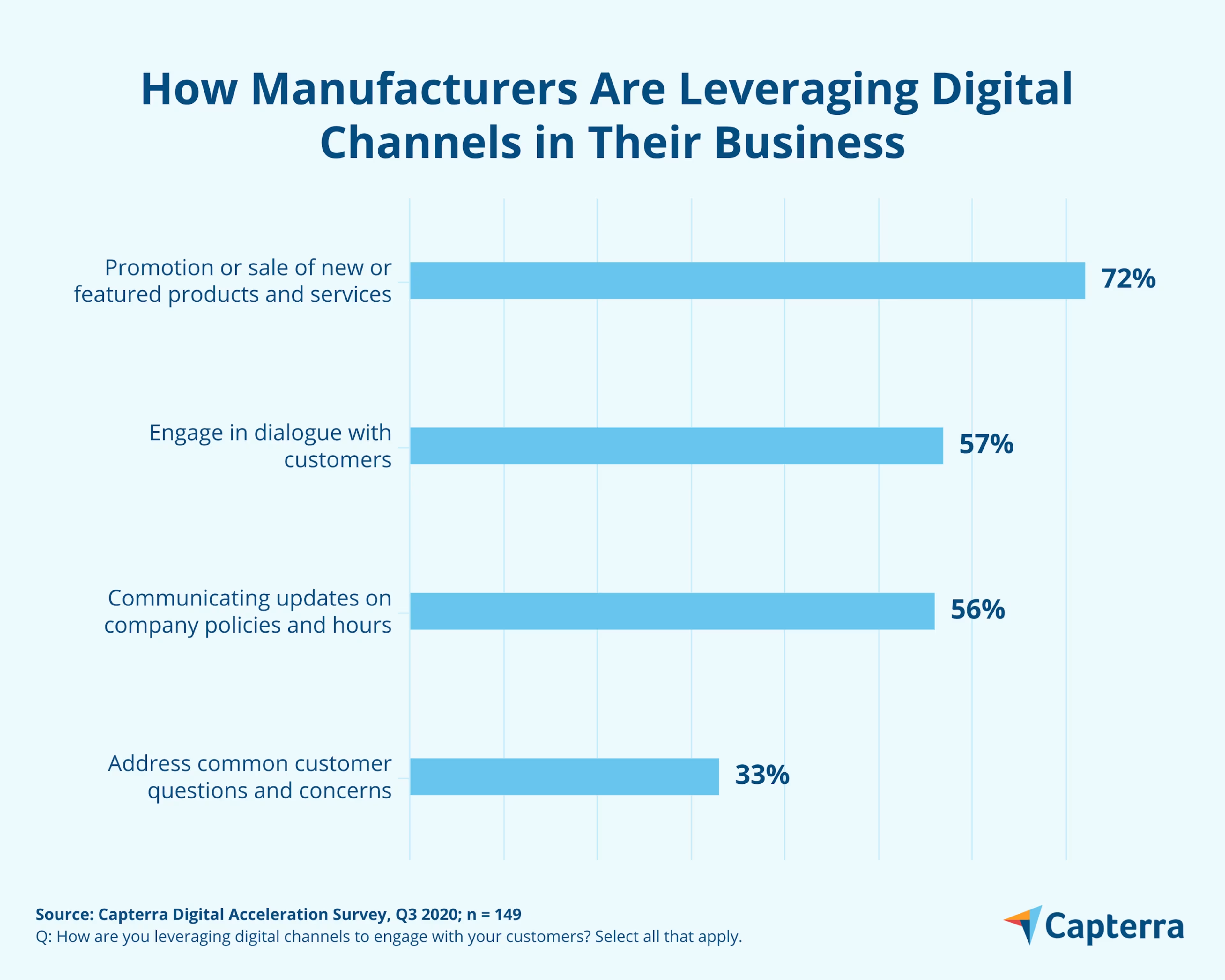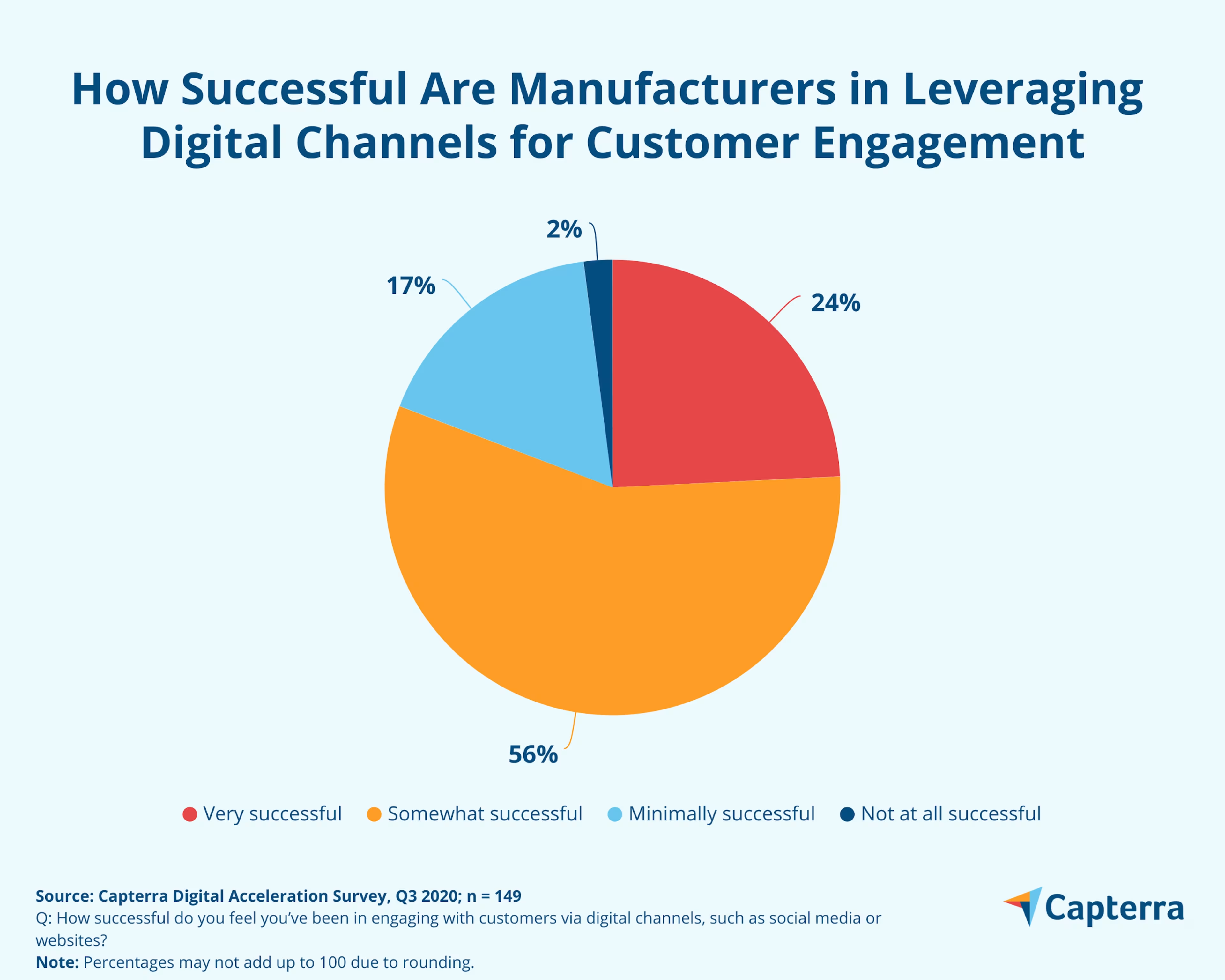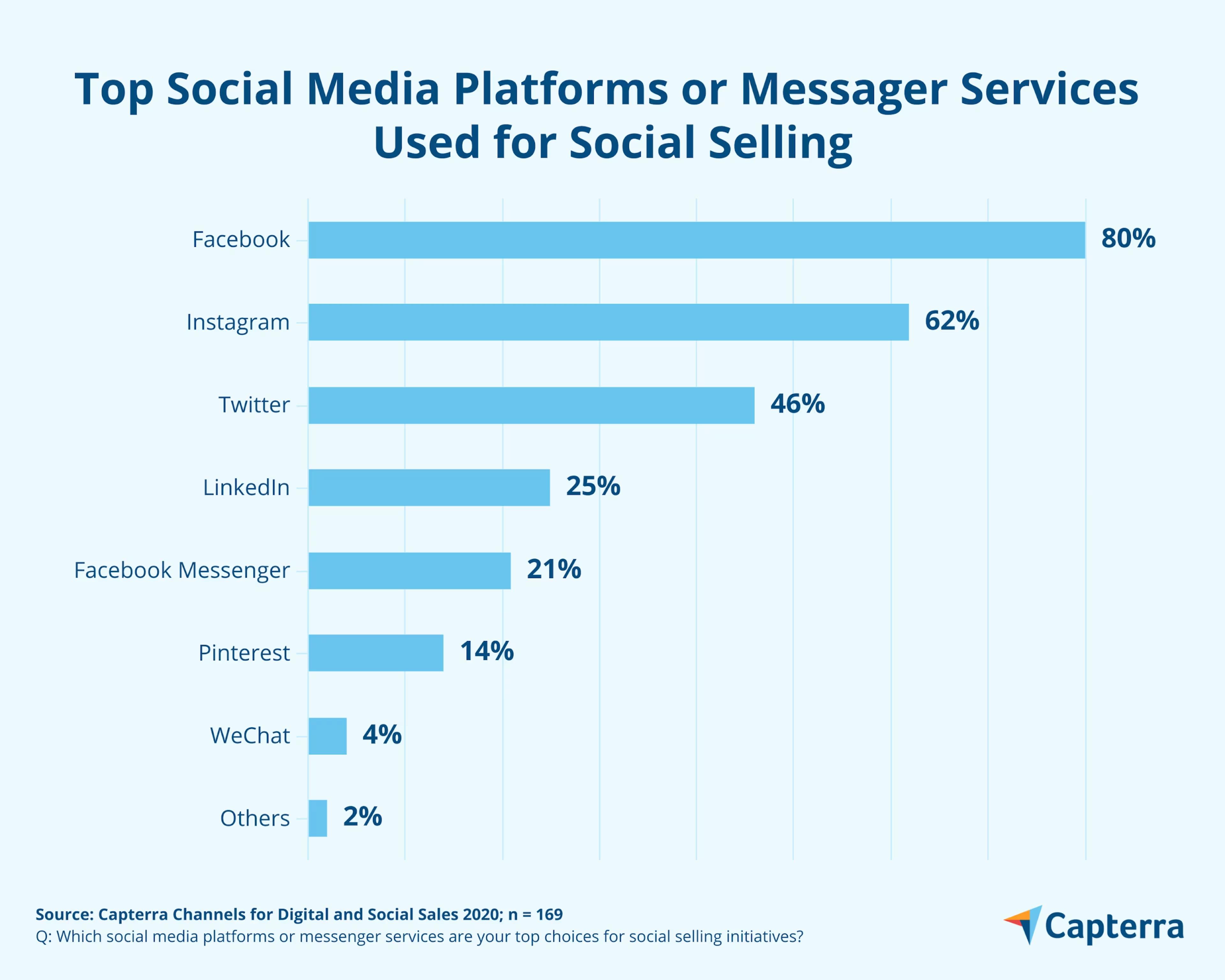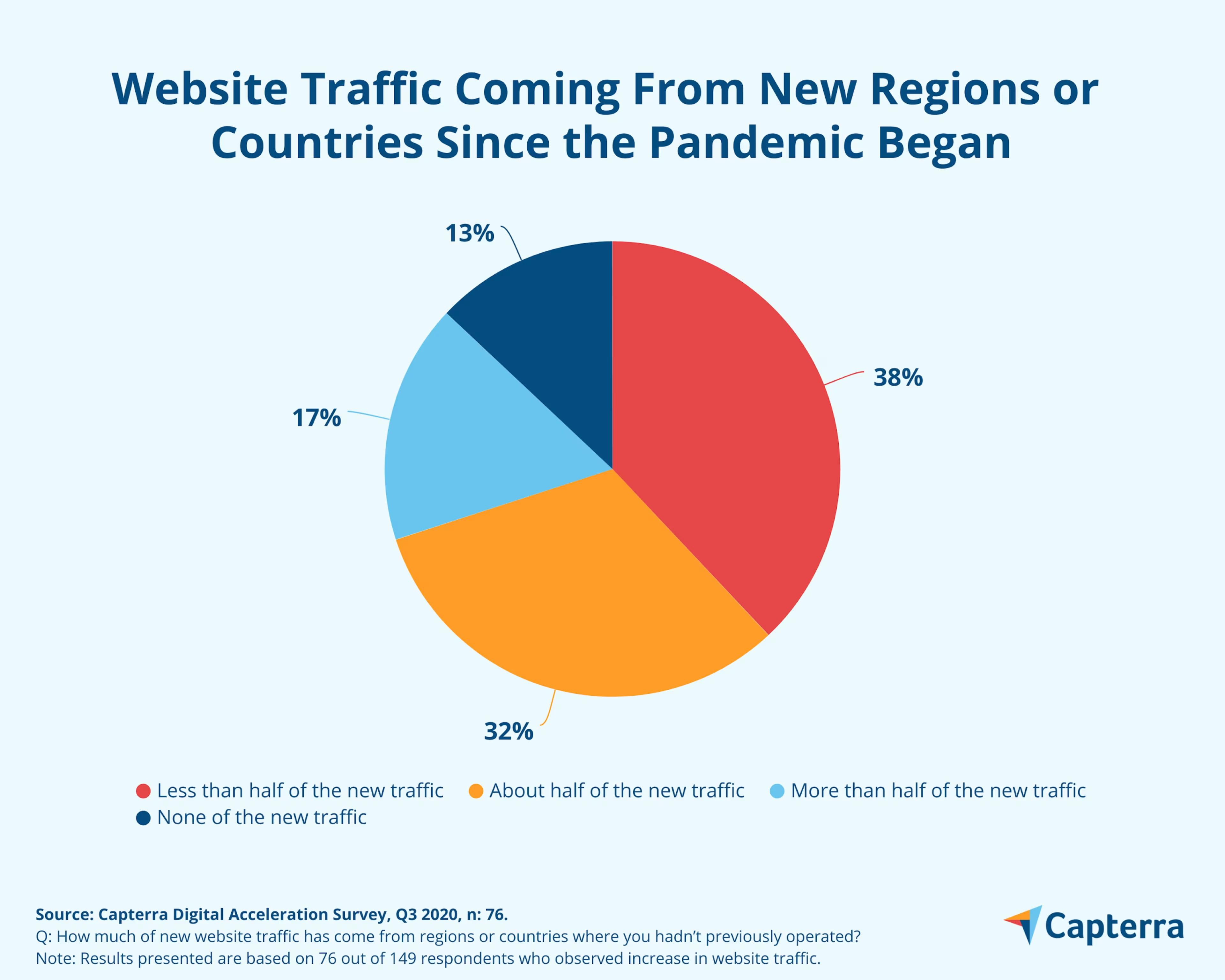Learn how your manufacturing business can leverage digital marketing tactics to remain relevant in a pandemic-hit market.

The COVID-19 pandemic landed manufacturing businesses like yours in uncharted waters overnight. Most had to cut production, and though demand is slowly getting back on track, the ways of doing business have changed altogether. Having an online presence is no longer an option for manufacturers like you—it’s become a necessity, and if you’re struggling with the transition, digital marketing can help.
But you may have questions like: How can digital marketing benefit my business in the current uncertain market? How are my fellow manufacturers leveraging digital marketing channels to promote their products and services? To get answers to these and similar questions, Capterra conducted an industry survey on existing digital marketing practices among manufacturers and how their adoption has shifted in response to COVID-19.
Here’s an interesting finding for you: Of the 149 manufacturing respondents, 98% found digital channels such as websites and social media helpful in engaging with customers, while 72% reportedly used these channels to promote their products online.
This report takes a deep dive into the survey data to explain why you should adopt digital marketing and how you can leverage the technology to optimize your online presence.
Why should you adopt digital marketing?
Your manufacturing company can benefit a lot from digital marketing strategies. Let’s look at how the technology can help your business plan for the future while adjusting to a world of social distancing.
Adapt to the “new normal”
In the post-pandemic market, doing business online is the new normal. Survey results show that since the onset of COVID-19, as much as 68% of respondents have moved their business processes online. This suggests that, from now on, the majority of buyer-seller interactions will happen digitally.
Digital marketing can help you adapt to the new normal by letting you build an online footprint. It makes it easier for customers to find you or research about you online. Any interested customer will want to check your website or social media, and if they don’t find you online, they may assume your business is not legitimate. It’s important to note, per our survey, 62% of manufacturing respondents have adopted digital marketing since the pandemic began.
Find new customers amid tough market conditions
In our survey, 39% of manufacturing respondents identified “finding new customers” as one of their top three priorities in the current market scenario. And since most customers are now online, that’s where you’ll be able to find them.
With digital marketing, you'll have access to a global online marketplace that has no geographic boundaries. You can interact with and sell to customers in any corner of the world, which isn’t possible using traditional marketing methods. You can share details of your offerings on social media, create attractive landing pages, use web forms to capture lead information, and much more to get prospects interested and increase their chances of conversion.
Establish brand credibility and awareness among customers
In the online selling model, nothing is more crucial than establishing brand credibility. In fact, 28% of manufacturing respondents in our survey mentioned “improving brand image” as a long-term business goal. Given there are hundreds of other manufacturers competing in the online space, what you do to gain customers’ trust and how you do it can make all the difference.
Using digital marketing tactics, you can reach out to customers with the information they need, address their queries in real time, create eCommerce listings to highlight the uniqueness of your offerings, and share testimonials from happy customers. This will help create a positive brand perception among customers as well as make them believe your business is a trustable one.
The digital shift is happening "now"
The digital transformation small businesses like yours were expected to make over years is now happening in months. Are you falling behind?

How are your peers using digital marketing?
As per survey results, most manufacturing respondents are currently using digital channels for three main purposes: promoting products online (72%), interacting with existing customers (57%), and communicating business updates (56%).

Survey data also shows that a large number of manufacturers have found digital channels effective in communicating with customers. 98% of respondents said they were successful in engaging with customers via these channels, of which 24% reported being “very successful.”

Top 3 digital marketing channels for your manufacturing business
To ensure your online marketing efforts are successful, you’ll need to identify the right channels for building brand awareness and promoting your products. In this section, we’ve discussed the top three channels used by most manufacturing companies.
1. Social media marketing
Social media marketing is one of the most effective tools to build or expand your online presence. Originally established for customer communication, this medium has now expanded its horizons to online lead generation and sales—think Instagram and Facebook stores. In our survey, 44% of respondents identified “social media marketing” as the top digital skill they anticipate needing most in the next six months.
Use social media channels to promote your products or services, build online user communities, share the content you’ve created (e.g., blogs, videos), interact with and take feedback from customers, engage influencers for paid promotions, and much more.
Focus on Facebook, Instagram, Twitter, and LinkedIn. Capterra’s Channels for Digital and Social Sales survey* indicates the prevalence of these platforms for social selling initiatives.

Pro tip
Invest in CRM software to manage social media leads efficiently. A CRM tool will let you manage online leads, store lead details, track interactions, and measure the success of your marketing efforts. As per our survey, 24% of manufacturing respondents were using CRM software before the pandemic; 54% use the software today.
2. Content marketing
Content marketing is all about creating and sharing content that’s likely to interest and engage your customers. It can be social media posts, blogs, customer reviews, product videos, infographics, case studies, etc.
Websites have become a crucial content marketing channel in the current business environment—51% of manufacturing respondents reported an increase in website traffic since the pandemic began. What’s more surprising, half of these respondents said the traffic increase came from countries where they hadn’t previously operated.

Pro tip
Have a blog section on your website to provide product or business information that enables buyers’ purchase decisions. Blog posts will give prospects an insight into your brand and its offerings as well as help target quality search engine optimization (SEO) traffic for your website.
If you don't have a website, consider investing in website builder software to create one. Here are some free options to get you started. Before the pandemic hit, 29% of surveyed manufacturers were using the software; that number has increased to 65% today.
3. eCommerce marketing
Due to COVID-19, retail sales have taken a hard hit, but eCommerce has helped counterbalance that impact. That’s a probable reason the adoption of eCommerce software has skyrocketed among manufacturers since the pandemic. As per our survey, 23% of manufacturing respondents were using eCommerce software pre-COVID, while 67% are using it now.
eCommerce marketing lets you expand operations beyond in-person sales, which means you can continue doing business even in today’s socially distanced world. It helps launch digital stores, list and advertise your products on eCommerce websites (Amazon, Etsy, etc.), track the shopping behavior of prospects, leverage user-generated content (e.g., reviews, feedback), and much more.
Pro tip
Selling to businesses is not the same as selling to customers. In a business-to-business (B2B) setup, you’ll have to tweak your offerings accordingly and attend to unique purchasing needs. Here are five top B2B eCommerce platforms to manage end-to-end online sales for your manufacturing company.
Create your digital marketing strategy in 3 steps
Creating a successful manufacturing marketing strategy requires a lot of planning and deliberation, without which your business will not be able to reap its benefits. Here’s a five-step approach you can use to design your digital marketing strategy.
Step #1: Identify the right channels
Perform an initial analysis of buyer demographics, per your line of business, to identify digital marketing channels best suited to your business requirements. Here’s our recommendation on these channels:
Channel | Most suitable for |
|---|---|
Social media marketing | Millennials and Generation Z buyers that use Facebook, Instagram, Twitter, etc. LinkedIn can be used to target similar B2B manufacturing clients. |
Content marketing | Buyers that do extensive research on product features, functionality, product roadmaps, pricing, alternatives, etc., before making a decision. |
eCommerce marketing | Buyers that prefer purchasing products on eCommerce platforms such as Amazon, eBay, and Etsy. |
Step #2: Perform the initial setup
After identifying the channels you’ll use, perform the initial setup for them.
Channel | Setup |
|---|---|
Social media marketing | Create accounts on all social media platforms, and maintain up-to-date business information on them. |
Content marketing | Design a website featuring your products and services. Update the website with blogs, customer testimonials, product videos, infographics, case studies, and more. |
eCommerce marketing | Create profiles and list your products on all identified eCommerce websites. Consider investing in an eCommerce solution for managing inventory and listings. |
Step #3: Designate a stakeholder for each channel
The next step is identifying stakeholders to manage and drive digital marketing efforts for all channels. We recommend using the following approach:
Channel | Approach |
|---|---|
Social media marketing | Identify a social media manager to manage campaigns across social channels. |
Content marketing | Build a team of writers to create content that promotes your offerings, explains their functionality, and addresses customers’ queries or pain points. Designate a content creation and marketing manager to oversee this team. |
eCommerce marketing | Identify an eCommerce specialist to create listings across eCommerce websites and update them regularly. |
Want to learn about hiring a digital marketing agency for your nonprofit? Our list of the top digital marketing agencies and their features will help you narrow your search. Read more in Capterra’s digital marketing agencies hiring guide.
Conclusion: How to make the best of your digital marketing efforts
Creating your online presence is not an overnight job but a continuous effort. Once you have a marketing plan, you’ll need to keep monitoring its performance. Track cost vs. profits, so you know how well your campaigns are doing. You can also explore paid campaigns to target a wider audience. Here are our recommendations on how to keep improving your digital marketing strategy:
Find new marketing channels: Stay on a constant lookout for new, innovative marketing channels. Involve all channel stakeholders in this process.
Audit campaigns: Review your campaigns regularly to identify areas for improvement.
Ensure close coordination between sales and marketing teams: The sales team can provide intelligent inputs on customer needs and preferences, and marketers can use these inputs to finetune campaigns. Thus, ensure both teams are working together.
In a competitive manufacturing industry, how well you monitor the performance of your digital marketing efforts will be the deciding factor. As your partner in successful digital transformation, our findings and recommendations are aimed at helping your business navigate the current uncertain market conditions.
How are your peers going digital
Small businesses like yours share how they're using technology to make the digital transition and navigate uncertain times.
